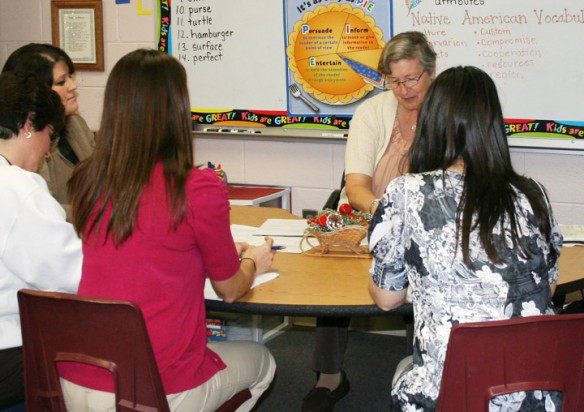
SWAT team member Judy Sizemore talks with 2nd-grade teachers during a meeting at Southside Elementary School (Pike County).
Photo provided by Southside Elementary School
By Matthew Tungate
matthew.tungate@education.ky.gov
Southside Elementary School (Pike County) was already on track to meeting proficiency standards on the Arts and Humanities Program Review this year before teaching artist Judy Sizemore arrived.
Sizemore, a consultant with the Kentucky Arts Council and KET, was very impressed with how the school had developed monthly arts themes that would be integrated into different subject areas. A 5th-grade teacher, Amy Carter, had even developed PowerPoint presentations for each of the themes that focused on terms, elements, and purposes of the arts.
But what really impressed Sizemore was that the school wanted to be more than just proficient on the Arts and Humanities Program Review.
That’s why Principal Jill Maynard has applied for numerous grants through the Kentucky Arts Council – including a new one called Specialists with Arts Tactics (SWAT) that brought Sizemore to the school.
“We’ve always taught art, but not to the depth that is required by the Program Review. Our kids have opportunities for art, it’s just not to the degree that they’re going to get it now,” Maynard said. “We want to do everything we can to provide our children with the best education possible, and according to the Kentucky Department of Education, these are the specific steps that you have to do to be distinguished, and we’re going to do that.”
Rachel Allen, the former arts education director with the Kentucky Arts Council, said the organization recognized that schools needed help not only providing better arts instruction, but also providing evidence of what they were already doing for the Program Review.
“We wanted to provide them with ways, after they evaluated it, they could improve those areas. It was our way to help the schools,” said Allen, who was an art teacher at Frankfort High School for three years before joining the Arts Council.
So last summer, the Arts Council started the SWAT program. As part of the program, the Arts Council provides schools with three- to six-hour consultancies by arts education professionals who will assist them with the components of the Arts and Humanities Program Review. Specifically, the art professionals assist schools in: writing policies; including the arts in the Comprehensive School Improvement Plan/Comprehensive District Improvement Plan (CSIP/CDIP); aligning arts curricula; developing performance assessments; and integrating the arts across the curriculum. The Arts Council pays the consultancy fees; schools pay travel and incidental costs.
Allen said the SWAT program is a way for schools to develop their programs. Just as schools have mathematics and literacy coaches, consultants can act as arts coaches, she said.
“I don’t think we can expect schools to know everything about every specific area, and if you can bring in an expert to help you with an area, then that’s great,” Allen said.
After a school is selected for the program, the Arts Council will give it three consultants to choose from based on its location and needs, she said. Consultants include teaching artists, former teachers and even current district-level employees, she said.
The Arts Council trained the consultants over the summer about school-based council policies, Program Reviews, CSIP and CDIP preparation, and best practices, Allen said.
Maynard said Carter, the school’s media specialist and music teacher met with Sizemore for a three-hour consultancy, then Sizemore returned to work with staff throughout the building for another three hours.
Sizemore said she likes to divide the consultancy into two parts. The first part is to find out what that school is doing with the arts and what it wants to focus on. She also will present some of her own ideas, look at available resources and how the school is using them, and what it might want to enhance.
In the second session, Sizemore works with groups of teachers by grade level, putting together recommendations and resources for each one based on the first session.
Carter said the SWAT consultancy is attractive because it allows an outside person to see if the school is on the right track. She said educators at Southside also wanted Sizemore to help them better integrate the arts into content areas rather than treating art as a separate subject.
“She gave us some really great ideas on how to make it more deliberate, to add that reflection piece and the assessment piece at the end to some of the things that we were already doing,” Carter said.
Sizemore said one of the things that she found was that teachers were including art in many lessons – though not necessarily in a way they could use for evidence on the Program Review or in a way that provided scaffolding in a learning target.
For example, the 5th grade social studies class did a unit on culture and societies. The teacher asked the students to make a flag, but she hadn’t explained the importance of symbols and colors, or provided an assessment, Sizemore said.
“That intentionality gives a greater chance for students to succeed, because they have a very specific idea, through the learning target, of what is expected,” she said.
Maynard said applying for the SWAT program didn’t take very long and has certainly been worth doing so.
“Anybody could apply for it, and I can’t imagine why they wouldn’t when they have such a resource available to them,” she said.
Finding good art professional development is difficult relative to finding resources for other subjects, Maynard said.
“No matter where you are there’s always room for improvement,” she said. “Having that resource available to a school is priceless.”




Leave A Comment